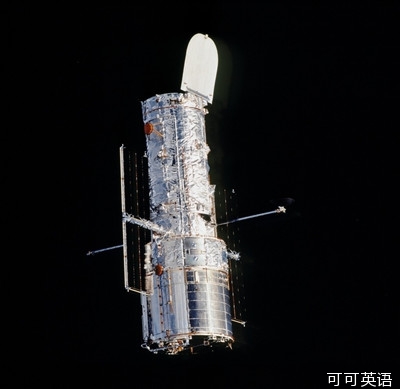Science and technology
科學技術
Astronomy
天文
Throwing money into space
往太空扔錢
A shiny new telescope is crowding out NASA's other science missions
新的望遠鏡正在把美國國家航空航天局其它科學任務擠出去
THE Hubble space telescope, an orbiting observatory launched in 1990 by NASA, America's space agency,
哈勃太空望遠鏡是1990年由美國國家航空航天局發(fā)射的繞地天文臺。
has been one of that agency's most successful missions since the Apollo moon shots in the 1960s and 1970s.
自六七十年代阿波羅登月發(fā)射以來,它一直是該局最成功的任務之一。
It has produced a string of scientific achievements:
它產(chǎn)生了一系列科學成就:
confirming that most galaxies have a black hole in the middle;
證實大多數(shù)星系中心存在一個黑洞;
providing a front-row seat for the collision, in 1994, of a comet with the planet Jupiter;
為人們提供了1994年蘇梅克—列維9號彗星撞擊木星的最佳觀測位置;
and helping to uncover the strange fact that the expansion of the universe seems to be accelerating.
幫助人們發(fā)現(xiàn)宇宙看上去正在加速擴張這一奇特事實。
But beyond the science, it has also been a public-relations hit.
但在科學以外,它也一直是承載科學和公眾交流的橋梁。
 Its beautiful images have introduced a generation to the wonders of astronomy.
Its beautiful images have introduced a generation to the wonders of astronomy.
它傳回的精美圖像引導一代人探索天文領域。
So in 2002, when the agency considered plans for a successor that would study the universe in infra-red,
因此,該局于2002年開始考慮籌劃哈勃望遠鏡的繼任者。
rather than visible light, would be ready to fly in 2010 and would cost just $2.5 billion, saying “yes” was easy.
耗資25億美元,通過紅外線,而非可見光研究宇宙的望遠鏡將于2010年升空,計劃輕松獲得通過。
Nine years later, NASA is regretting that decision.
九年后,美國國家航空航天局對當時所作出的決定感到愧疚。
The James Webb space telescope, as the new machine is called, is still in the workshop, and its launch date has been set back repeatedly.
這個被稱為詹姆斯·韋伯的新望遠鏡仍在廠房里。
Its cost has gone up to $8.8 billion, a figure that, if history is any guide, could rise still further.
其發(fā)射日期一推再推該望遠鏡耗資已攀升至88億美元,歷史如果有其它可能,這一數(shù)字還是會進一步攀升。
Which would be embarrassing at the best of times, but with public-spending cuts looming and NASA's budget flat for the foreseeable future, it is causing real strains.
這是最讓人為難的時刻,但隨著削減公共開支初見端倪,美國國家航空航天局將在可預見的未來里保持預算不變,這正引起真正的緊張。
In July, irritated by the JWST's rising costs, the House of Representatives tried to cut $1.9 billion from NASA's budget for next year, in an attempt to have the project cancelled.
7月,出于對詹姆斯·韋伯望遠鏡不斷攀升的開支不滿,眾議院試圖從美國國家航空航天局下一年預算里砍掉19億美元,以求取消這項計劃。
On November 1st, after lobbying from the telescope's defenders, the Senate passed a bill that restored the telescope's funding.
11月1日,經(jīng)為新望遠鏡進行辯護的人游說后,參議院通過了一項恢復望遠鏡資助的法案。
But it is not just politicians that are restive.
但并不僅僅是政治家感到不安,
Astronomers have long worried that the ballooning costs of the telescope would affect NASA's other science projects.
天文學家一直擔心該望遠鏡激增的開支會影響到美國國家航空航天局其它科研項目。
Officially, the space agency will say only that other missions will be delayed,
從官方角度看,他們只會表示其它任務將會推后,
but there are fears that some could be cut completely.
但人們擔心其中一些會完全被砍掉。
One potential sacrifice is WFIRST, an infra-red space telescope intended for launch in 2020.
其中一個潛在的犧牲品就是寬視場紅外巡天望遠鏡,一個計劃在2020年發(fā)射的紅外線天文望遠鏡。
This is designed to probe the nature of “dark energy”, which is thought to be responsible for the quickening expansion of the universe that Hubble helped bring to the world's attention.
這部望遠鏡設計出來是為了探測自然界里的“暗能量”,
A string of other, smaller projects could suffer as well.
該物質被認為是經(jīng)哈勃引起全世界關注的宇宙加速擴張的原因。
The telescope's advocates say junking it now would be a false economy.
該望遠鏡的支持者稱現(xiàn)在拋棄它不值當。
Most of the hardware has already been built, so cancelling it, they argue, would mean throwing all that away.
他們認為,大多數(shù)硬件都已造好,就這么取消意味著將這些東西統(tǒng)統(tǒng)扔掉。
And they play on fears that America is in danger of losing its pre-eminence in high-budget “big science”,
繼今年年初功率為世界第二的粒子加速器,設在伊利諾伊州的垓電子伏加速器關閉后,美國處于逐漸失去建立在對“大科學”
following the closure earlier this year of the Illinois-based Tevatron, the second-most-powerful particle accelerator in the world.
高投入的卓越地位的危險中,望遠鏡支持者利用了這些恐慌。
The JWST, if it does eventually fly, would surely do some spectacular science.
如果詹姆斯·韋伯望遠鏡最終得以發(fā)射,它肯定會開展一些驚人的科研。
The size of its mirror—25 square metres, as against Hubble's 4.5—and the location of its orbit far from the reflected light of Earth will allow it to study some of the earliest events in the universe,
相對于哈勃4.5平米大的鏡頭,新望遠鏡達到25平米—它的軌道也遠離地球反射光,可以讓它對一些宇宙最早的事件進行研究,
including the formation of the first galaxies. It will also help with the search for extrasolar planets.
包括第一個星系的形成,幫助科學家尋找太陽系外的行星。
Hubble, of course, was also late—and around $2 billion over budget.
不久前哈勃的預算也超過約20億美元。
It was lampooned after its launch when a wonky mirror meant that its images were blurred almost to the point of uselessness, and a mission by the Space Shuttle to fix the problem cost hundreds of millions of dollars.
諷刺的是,發(fā)射升空后,其搖晃的鏡頭意味著圖像虛到幾乎沒有任何用處,后經(jīng)航天飛機完成的修補任務耗資上億美元。
Given its subsequent record, few now begrudge the cost.
鑒于其后來的成績,現(xiàn)在很少有人肉疼這筆錢。
With all that in mind, NASA will press on with the JWST, at least for now.
考慮到所有這些,美國國家航空航天局也許會推動詹姆斯·韋伯望遠鏡,至少現(xiàn)在是。
All that remains for America's astronomers to do is pray that their favourite mission is not one of those delayed, or even cancelled, to keep the new telescope on track.
對于美國天文學家來說,他們剩下要做的就是祈求他們鐘愛的任務沒在那些被推遲的里面,或者即使被取消,也要讓新望遠鏡保持運作。











